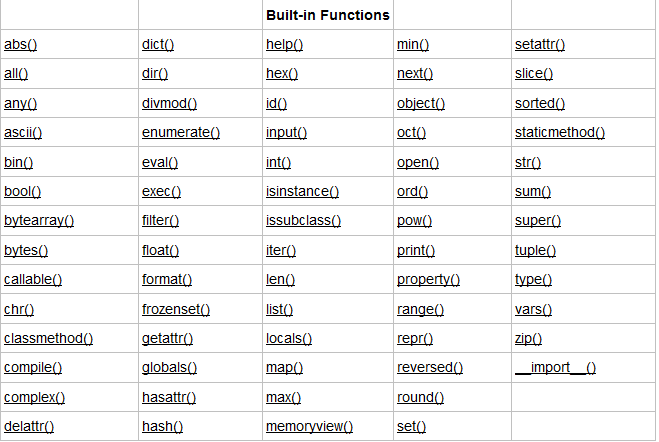一、内置函数接下来,我们就一起来看看python里的内置函数

分类图

1、作用域函数
基于字典的形式获取局部变量和全局变量
globals()——获取全局变量的字典
locals()——获取执行本方法所在命名空间内的局部变量的字典
2、字符串代码执行
# eval() 将字符串类型的代码执行并返回结果 # print(eval('1+2+3+4'))exec()将自字符串类型的代码执行 # print(eval("3 > 1" )) # 注意不能接受一个等式,返回的是一个值,如果是输入内容则返回,一般用于简单求值表达式用eval # exec("print('hello,world')") #exec 将自字符串类型的代码执行 没有返回值。格式和正常代码格式一样不能随意修改 # exec( '''a = input('请输入》》') # if a != 1: # print(a)''') # a = 123 # print(a) # compile 将字符串类型的代码编译 # 编译成code类 #交互语句用single # code3 = 'name = input("please input your name:")' # compile3 = compile(code3,'','exec') #name #执行前name变量不存在 # Traceback (most recent call last): # File "<pyshell#29>", line 1, in <module> # name # NameError: name 'name' is not defined # exec(compile3) #执行时显示交互命令,提示输入 # print(name) # name #执行后name变量有值 # "'pythoner'" # a = "input('>>>')" # b = compile(a,'','exec') # print(b,type(b),sep='**',) # exec (b) # cmp_code = compile('print("single")','','single') # exec(cmp_code) # eval_code='1+2' #如果用模式用single 将变成会返回值的一种 其他的都变成 有返回值 经过compile # cmp_code2=compile(eval_code,'','eval') # print(exec(cmp_code2)) #single 单一交互语句,多个交互语句报错 c = '''input('>>>') input('>>>')''' cmp_code=compile(c,'','single') exec(cmp_code) # multiple statements found while compiling a single statement
其他:
#1.迭代器相关range ,next(),iter(),send #可调用函数 callable 返回True or Flase #ctrl + 左键单击 :pycharm #5.help:包含所有方法名以及他的使用方法 —— 不知道用法 #6.dir:只包含方法名 —— 想查看某方法是否在这个数据类型中 #7.import 函数 import time import os import urllib.request import os.path import copy #8.open 文件操作 # f = open('文件名','w',encoding='utf-8') #打开模式:r、w、a、rb、wb,ab #9.内存地址 id() #10 hash地址 hash() #11#数据的存储和查找 #模块:hashlib # {'k':'v'} # [1,2,3,4,5,6,] # hash([1,2,3,4,5,6,]) #hash 判断一个数据类型是否可以hash #在一个程序执行的过程中,对同一个值hash的结果总是不变 #多次执行,对同一个值的hash结果可能改变 #12 用户交互 input() 返回的值是字符串 # with open('a','a') as f: # f.write('asdf') # 13 pow 幂运算 # print(pow(3,2.5)) #15.588457268119896 #14 slice # l = [1,2,23,213,5612,342,43] # sli = slice(1,5,2) #实现了切片的函数 # print(l[sli]) # 15 bytearray # ret = bytearray('alex',encoding='utf-8') #对比较长的字符串做修改的时候,指定某一处进行修改,不会改变这个bytearry的内存地址 # print(id(ret)) # print(ret[0]) # ret[0] = 65 # print(ret) # print(id(ret)) #16 memoryview 内存中的切片 所谓内存查看对象,是指对支持缓冲区协议的数据进行包装,在不需要复制对象基础上允许Python代码访问。 #. Python内置对象中支持缓冲区协议的对象有bytes和bytearray。 #切片 # l = [1,2,3,4,5,60] # l[1:3] # ret = memoryview(bytes('你好',encoding='utf-8')) # print(ret) # print(len(ret)) # print(ret[:3]) # print(bytes(ret[:3]).decode('utf-8')) # print(bytes(ret[3:]).decode('utf-8')) # 17 repr 显示表现形式 ascii 显示二进制表现形式 print(repr(1)) print(repr('1')) print('name : %r'%('金老板')) print(ascii(1)) print(ascii('1')) print('name : %r'%('金老板'))

import time for i in range(0,101,2): time.sleep(0.1) char_num = i//2 #打印多少个'*' per_str = ' %s%% :�33[1;40m %s�33[0m ' % (i, '*' * char_num) if i == 100 else ' %s%% : �33[1;40m%s�33[0m'%(i,'*'*char_num) print(per_str,end='', flush=True)
